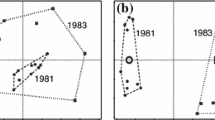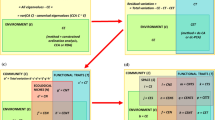Abstract
This paper addresses the question of studying the joint structure of three data tablesR,L andQ. In our motivating ecological example, the central tableL is a sites-by-species table that contains the number of organisms of a set of species that occurs at a set of sites. At the margins ofL are the sites-by-environment data tableR and the species-by-trait data table Q. For relating the biological traits of organisms to the characteristics of the environment in which they live, we propose a statistical technique calledRLQ analysis (R-mode linked toQ-mode), which consists in the general singular value decomposition of the triplet (R t D I LD J Q,D q ,D p ) whereD I ,D J ,D q ,D p are diagonal weight matrices, which are chosen in relation to the type of data that is being analyzed (quantitative, qualitative, etc.). In the special case where the central table is analysed by correspondence analysis,RLQ maximizes the covariance between linear combinations of columns ofR andQ. An example in bird ecology illustrates the potential of this method for community ecologists.
Similar content being viewed by others
References
Austin, M.P. (1968) An ordination study of a chalk grassland community.Journal of Ecology 56, 739–57.
Bayley, P.B. and Li, H.W. (1992) Riverine fishes. InThe River Handbook, P. Calow and G.E. Petts (eds), Blackwell, Oxford, pp. 251–81.
Blondel, J., Ferry, C., and Frochot, B. (1981) Point counts with unlimited distance. InEstimating the numbers of terrestrial birds, C.J. Ralph and J.M. Scott (eds),Studies in Avian Biology 6, 414–20.
Böckenholt, U. and Böckenholt, I. (1990) Canonical analysis on contingency tables with linear constraints.Psychometrika 55, 633–9.
Bournaud, M., Richoux, P., and Usseglio-Polatera, P. (1992) An approach to the synthesis of qualitative ecological information issued from aquatic Coleoptera communities.Regulated Rivers: Research and Management 7, 165–80.
Cellot, B., Dole-Olivier, M.J., Bornette, G. and Pautou, G. (1994) Temporal and spatial environmental variability in the Upper Rhône River and its floodplain.Freshwater Biology 31, 311–25.
Chessel, D., Lebreton, J.D., and Yoccoz, N. (1987) Propriétés de l'analyse canonique des correspondances. Une utilisation en hydrobiologie.Revue de Statistique Appliquée 35, 55–72.
Chevenet, F., Doledéc, S., and Chessel, D. (1994) A fuzzy coding approach for the analysis of long-term ecological data.Freshwater Biology 31, 295–309.
Dolédec, S., and Chessel, D. (1994) Co-inertia analysis: an alternative method for studying species-environment relationships.Freshwater Biology 31, 277–94.
Escoufier, Y. (1982) L'analyse des tableaux de contingence simples et multiples.Metron 40, 53–77.
Escoufier, Y. (1987) The duality diagram: a means of better practical applications. InDevelopment in numerical ecology, P. Legendre and L. Legendre (eds), Springer-Verlag, Berlin, pp. 139–56.
Fraile, L., Escoufier, Y., and Raibaut, A. (1993) Analyse des correspondances de données planifiées: Etude de la chémotaxie de la larve infestante d'un parasite.Biometrics 49, 1142–53.
Gittins, R. (1985)Canonical analysis, a review with applications in ecology. Springer-Verlag, Berlin.
Greenacre, M.J. (1984)Theory and applications of correspondence analysis. Academic Press, London.
Grime, J.P. (1974) Vegetation classification by reference to strategies.Nature 250, 26–31.
Haefner, J.W. (1978) Ecosystem assembly grammars: generative capacity and empirical adequacy.Journal of Theoretical Biology 73, 293–315.
Hansen, A.J. and Urban, D.L. (1992) Avian response to landscape pattern: the role of species' life histories.Landscape Ecology 7, 163–80.
Hill, M.O. (1973) Reciprocal averaging: an eigenvector method of ordination.Journal of Ecology 61, 237–49.
Kazi-Aoual, F., Hitier, S., Sabatier, R., and Lebreton, J.D. (1995) Refined approximations to permutation tests for multivariate inference.Computational Statistics and Data Analysis 20, 643–56.
Keddy, P.A. (1992) Assembly and response rules: two goals for predictive community ecology.Journal of Vegetation Sciences 3, 157–64.
Lebreton, J.D. and Yoccoz, N. (1987) Multivariate analysis of bird count data.Acta Œcologica, Œcologia Generalis 8, 125–44.
Lebreton, J.D., Sabatier, R., Banco, G., and Bacou, A.M. (1991) Principal component and correspondence analyses with respect to instrumental variables: an overview of their role in studies of structure-activity and species-environment relationships. InApplied Multivariate Analysis in SAR and environmental studies, J. Devillers and W. Karcher (eds), Kluwer Academic, Dordrecht, The Netherlands, pp. 85–114.
Mercier, P., Chessel, D. and Doledec, S. (1992) Complete analysis of an ecological profile data table: a central ordination method.Acta Œcologica 13, 25–44.
Noy-Meir, I. (1973) Data transformations in ecological ordination. I. Some advantages of non-centering.Journal of Ecology 61, 329–41.
Palmer, M.W. (1993) Putting things in even better order: the advantages of canonical correspondence analysis.Ecology 74, 2215–30.
Poff, N.L. and Ward, J.V. (1990) Physical habitat template of lotic systems: recovery in the context of historical pattern of spatiotemporal heterogeneity.Environmental Management 40, 1713–18.
Rice, R.P., Ohmart, R.D., and Anderson, B.W. (1983) Habitat selection attributes of an avian community: a discriminant analysis investigation.Ecological Monographs 53, 263–90.
Southwood, T.R.E. (1977) Habitat, the templet for ecological strategies?Journal of Animal Ecology 46, 337–65.
Southwood, T.R.E. (1968) Tactics, strategies and templets.Oikos 52, 3–18.
Statzner, B., Resh, V.H., and Dolédec, S. (eds) (1994a) Ecology of the Upper Rh6ne River: a test of habitat templet theories.Freshwater Biology 31, 253–554.
Statzner, B., Resh, V.H., and Roux, A.L. (1994b) The synthesis of long-term ecological research in the context of concurrently developed ecological theory: design of a research strategy for the Upper Rhône River and its floodplain.Freshwater Biology 31, 253–63.
Takane, Y. and Shibayama, T. (1991) Principal component analysis with external information on both subjects and variables.Psychometrika 56, 97–120.
Tatibouet, F. (1981) Approche écologique d'un établissement humain (environnement et structure). Exemple de la communauté urbaine de Lyon. Thesis, University of Lyon 1.
Tenenhaus, M. and Young F.W. (1985) An analysis and synthesis of multiple correspondence analysis, optimal scaling, dual scaling, homogeneity analysis and other methods for quantifying categorical multivariate data.Psychometrika 50, 91–119.
Ter Braak, C.J.F. (1986) Canonical correspondence analysis: a new eigenvector technique for multivariate direct gradient analysis.Ecology 67, 1167–79.
Ter Braak, C.J.F. and Barendregt, L.G. (1986) Weighted averaging of species indicator values: its efficiency in environmental calibration.Mathematical Biosciences 78, 52–72.
Ter Braak, C.J.F. and Juggins, S. (1993) Weighted averaging partial least squares regression (WA-PLS): an improved method for reconstructing environmental variables from species assemblages.Hydrobiologia 269/270, 485–502.
Ter Braak, C.J.F. and Verdonschot, P.F.M. (1995) Canonical correspondence analysis and related multivariate methods in aquatic ecology.Aquatic Sciences 57, 255–89.
Thioulouse, J. and Chessel, D. (1992) A method for reciprocal scaling of species tolerance and sample diversity.Ecology 73, 670–80.
Thioulouse, J., Dolédec, S., Chessel, D., and Olivier, J.M. (1995) ADE software: multivariate analysis and graphical display of environmental data.Proceedings of the 4th International Software Exhibition for Environmental Science and Engineering, pp. 57–62.
Townsend, C.R. and Hildrew, A.G. (1994) Species traits in relation to a habitat templet for river systems.Freshwater Biology 31, 265–75.
Whittaker, R.H. (1967) Gradient analysis of vegetation.Biological Reviews of the Cambridge Philosophical Society 42, 207–64.
Wiens, J.A. (1991) Ecological similarity of shrub-desert avifaunas of Australia and North America.Ecology 72, 479–95.
Williams, E.J. (1952) Use of scores for the analysis of association in contingency tables.Biometrika 39, 274–89.
Author information
Authors and Affiliations
Rights and permissions
About this article
Cite this article
Dolédec, S., Chessel, D., ter Braak, C.J.F. et al. Matching species traits to environmental variables: a new three-table ordination method. Environ Ecol Stat 3, 143–166 (1996). https://doi.org/10.1007/BF02427859
Received:
Revised:
Issue Date:
DOI: https://doi.org/10.1007/BF02427859




